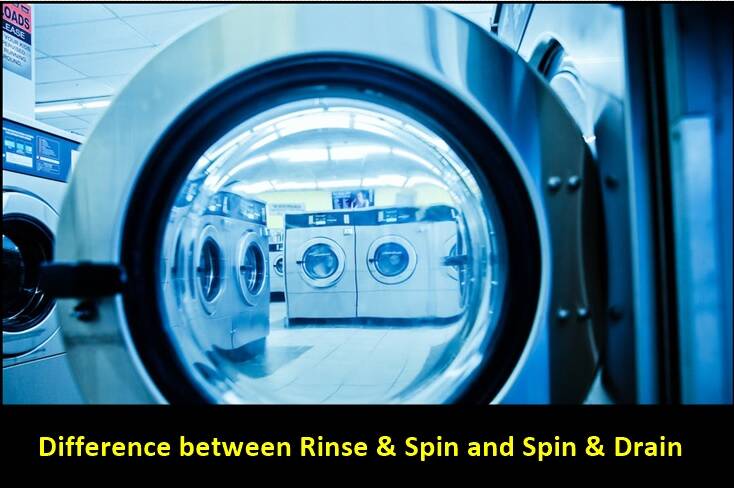Ever find yourself standing in front of your washing machine, staring at the array of buttons and settings, and pondering the mysterious world of laundry cycles? If you’ve ever wondered about the difference between “rinse & spin” and “drain & spin” options, you’re not alone. In the rhythm of laundry day, these settings might seem like mere variations, but there’s more to them than meets the eye. Let’s embark on a sudsy exploration to unravel the mystery of what sets “rinse & spin” apart from “spin & drain” in the realm of washing machines. So, grab a cup of fabric softener, settle into your laundry room throne, and let’s dive into the spin cycle of washing machine wizardry!
Understanding the drain & spin cycle
When it comes to laundry, the drain & spin cycle is an essential step in the washing process. This cycle is designed to remove excess water from your clothes after the wash, leaving them damp and ready for drying. The cycle begins by draining the soapy water from the drum, effectively removing any dirt, grime, or detergent residue that may have accumulated during the wash. Once the water is drained, the machine moves on to the spinning phase. This spinning motion helps to extract as much water as possible from the clothes, reducing their drying time significantly. The clothes are spun at a high speed, causing the water to be forced out through the small holes in the drum, leaving them damp but not dripping wet.
The drain & spin cycle is particularly useful in situations where you need to remove excess water from your clothes without subjecting them to a full wash cycle. For example, if you’ve accidentally spilled something on your favorite shirt and want to quickly rinse it out without washing the entire load, the drain & spin cycle can come to your rescue. It’s also handy when you’ve washed your clothes but didn’t have time to immediately take them out of the machine. Running a drain & spin cycle can prevent your clothes from sitting in a pool of water for an extended period, minimizing the chances of them becoming musty or developing an unpleasant odor.
In summary, the drain & spin cycle is a valuable feature that allows you to remove excess water from your clothes after a wash. It helps speed up the drying process and is particularly useful for quick rinses or preventing clothes from sitting in a damp environment for too long.
What is Rinse and Spin?
Now that we’ve explored the drain & spin cycle, let’s turn our attention to its counterpart, the rinse & spin cycle. As the name suggests, this cycle involves rinsing your clothes without the use of detergent, followed by a spin to remove the water. While the drain & spin cycle focuses on removing excess water after a wash, the rinse & spin cycle is all about giving your clothes a thorough rinse, without the need for a full wash cycle.
During the rinse & spin cycle, the washing machine fills up with clean water, and the clothes are agitated to remove any remaining detergent or residue from the previous wash. This additional rinse helps to ensure that your clothes are left clean and fresh, free from any lingering traces of soap. After the rinse, the machine moves on to the spinning phase, where the clothes are spun at a high speed to extract the water, leaving them damp and ready for drying.
The rinse & spin cycle is particularly beneficial when you want to remove any traces of detergent from your clothes, especially if you or your family members have sensitive skin or allergies. It can also be useful for refreshing lightly soiled clothes or for giving a quick rinse to items that have been worn briefly and don’t require a full wash. Additionally, the rinse & spin cycle can be employed as a pre-treatment step before running a regular wash cycle, ensuring that your clothes start the cleaning process with a fresh rinse.
Also Read:
How to Repair a Broken Dryer Belt: Step-by-Step Guide
Rinse and Spin vs Drain and Spin
Now that we have a clear understanding of what the rinse & spin and drain & spin cycles entail, let’s compare the two to better understand their differences.
The main difference between rinse & spin and drain & spin lies in the purpose of each cycle. Rinse & spin focuses on rinsing clothes and removing detergent residue, while drain & spin is primarily concerned with removing excess water after a wash. While both cycles involve spinning the clothes to extract water, the rinse & spin cycle also includes a rinsing phase.
Another difference lies in the use of detergent. In the rinse & spin cycle, detergent is not added since the primary goal is to rinse the clothes. On the other hand, the drain & spin cycle is typically part of a regular wash cycle, where detergent is used to clean the clothes.
In terms of time and energy efficiency, the drain & spin cycle is generally quicker since it only involves draining the water and spinning the clothes. The rinse & spin cycle, on the other hand, requires filling the machine with clean water, agitating the clothes, and then spinning them. As a result, the rinse & spin cycle takes longer to complete.
Ultimately, the choice between rinse & spin and drain & spin depends on your specific laundry needs. If you’re looking to remove excess water after a wash or want to quickly rinse a lightly soiled garment, the drain & spin cycle is the way to go. On the other hand, if you want to give your clothes a thorough rinse or remove detergent residue, the rinse & spin cycle is the better option.
When to Use Drain and Spin
The drain & spin cycle can be beneficial in various situations. Here are some instances when it’s advisable to use the drain & spin option:
- Removing excess water: If you’ve hand-washed delicate items or soaked clothes in a bucket, using the drain & spin cycle can help remove excess water without subjecting the clothes to a full wash cycle.
- Quick rinses: If you’ve spilled something on a specific garment and want to rinse it quickly without washing the entire load, the drain & spin cycle allows for a swift removal of the spillage.
- Preventing musty odors: If you’ve washed your clothes but can’t immediately take them out of the machine, running a drain & spin cycle can prevent the clothes from sitting in a damp environment for too long, reducing the chances of them developing an unpleasant odor.
By utilizing the drain & spin cycle in these situations, you can save time and reduce the risk of damage to your clothes.
When to Use Rinse and Spin
The rinse & spin cycle is particularly useful in the following scenarios:
- Removing detergent residue: If you or your family members have sensitive skin or allergies, running a rinse & spin cycle can help remove any lingering traces of detergent from your clothes, ensuring they are free from irritants.
- Refreshing lightly soiled clothes: If you have clothes that have been worn briefly and are only lightly soiled, a rinse & spin cycle can freshen them up without the need for a full wash.
- Pre-treatment before a wash: The rinse & spin cycle can serve as a pre-treatment step before running a regular wash cycle. By starting with a fresh rinse, you can ensure that your clothes are thoroughly cleaned.
In these situations, utilizing the rinse & spin cycle can help improve the cleanliness and freshness of your clothes.
Another Useful Read:
How to Reset Rheem Classic Air Conditioner | The Ultimate Guide
Final Thoughts
In the world of washing machines, the differences between the rinse & spin and drain & spin cycles may seem subtle, but they serve distinct purposes. The drain & spin cycle focuses on removing excess water after a wash, while the rinse & spin cycle provides a thorough rinse to remove detergent residue and refresh clothes. Understanding when to use each cycle can help optimize your laundry routine, saving time and ensuring your clothes come out clean and fresh. So, the next time you find yourself in front of your washing machine, armed with the knowledge of rinse & spin versus drain & spin, you can confidently select the cycle that best suits your laundry needs. Happy washing!

Hello, I’m James, the founder of FixitAllSecure.com. With over 10 years of experience in appliance repair, I’ve made it my mission to assist homeowners like you in resolving appliance issues, saving you precious time and money. From practical repair guides to prevention tips, I’m here to ensure your appliances run smoothly and your household stays stress-free.


